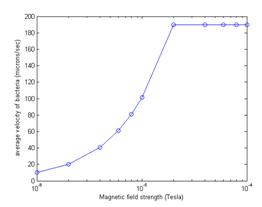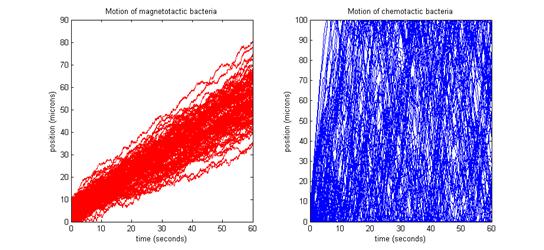Team:BCCS-Bristol/BSim/Case studies/Magnetotaxis
From 2009.igem.org
(New page: {{:Team:BCCS-Bristol/Header}} = Magnetotaxis = Magnetotactic bacteria are gram-negative, motile (by means of a flagella) bacteria. Each one forms a string of intracellular magnetic gra...) |
|||
| (18 intermediate revisions not shown) | |||
| Line 2: | Line 2: | ||
| + | <html><center> | ||
| + | <object width="425" height="344"><param name="movie" value="http://www.youtube.com/v/joMxPbb09Ds&hl=en&fs=1"></param><param name="allowFullScreen" value="true"></param><param name="allowscriptaccess" value="always"></param><embed src="http://www.youtube.com/v/joMxPbb09Ds&hl=en&fs=1" type="application/x-shockwave-flash" allowscriptaccess="always" allowfullscreen="true" width="425" height="344"></embed></object> | ||
| + | </center></html> | ||
| - | + | The video shows magnetotactic bacteria influenced by a magnetic field strength of 7.53x10^(-6) Tesla. The field direction controls the alignment of the bacteria, but not the speed that they travel at. The higher the field direction, the stronger the alignment of the bacteria with the field direction. | |
| - | + | ==Experiment: Effect of magnetic field strength on average velocity of bacteria== | |
| - | + | Several experiments were carried out on the bacteria. The first was to look at the effect of varying the magnetic field strength on the average velocity of the bacteria. The graph (Figure 1) below shows the result of this. As can be seen, there is a maximum average velocity of the bacteria after which increasing the magnetic field strength has no further effect on the magnetic dipole moment of the bacteria. | |
| - | + | [[Image:BCCS-Bristol_VaryingFieldOnVelocity.jpg|center|frame|Figure 1: Graph of the effect of varying the magnetic field strength on the average velocity of the bacteria.]] | |
| - | + | ==Experiment: Magnetotaxis versus chemotaxis== | |
| - | + | The next experiment was to compare the magnetotactic bacteria with the chemotactic effects on bacteria. | |
| - | + | Using a chemical concentration of aspartate, the average velocity of the bacteria is not affected by different concentrations, as the bacteria will only detact a change, not by how much it has changed. Running this simulation for 100 bacteria, it was found that the average velocity of the bacteria was 76.30 microns/second. | |
| - | + | In order to run a simulation with the same average velocity of magnetotactic bacteria instead, the magnetic field strength must be equal to 7.53x10^(-6) Tesla. | |
| - | + | Additionally, the magnetic field strength can still be increased further, thereby increasing the average velocity of magnetotactic bacteria higher than that of chemotactic bacteria. | |
| - | + | Finally, the ability to control the positions of the bacteria was compared for the two cases. The plots below (Figure 2) show the locations over time of individual bacteria, with magnetotactic bacteria on the left and chemotactic bacteria on the right. Clearly, while the two methods have the same average velocity, the deviation of the magnetotactic bacteria is much smaller. This means that it is easier to predict the location of a particular bacteria and so they are more easily controllable. | |
| - | [[Image:BCCS- | + | [[Image:BCCS-Bristol_MagnetotaxisVsChemotaxis.jpg|center|frame|Figure 2: Plots showing the location of individual bacteria over time in one directional axis. On the left is magnetotactic bacteria and on the right is chemotactic bacteria.]] |
| - | + | While magnetotactic e. coli may be some way off, the desire to work on this can be understood when these experiments can show so clearly the distinct advantage as far as velocity and controllability in the use of magnetotactic bacteria as opposed to chemotactic bacteria. | |
| - | + | ||
| - | + | ||
| - | + | ||
| - | + | ||
| - | + | ||
| - | + | ||
| - | + | ||
| - | + | ||
| - | + | ||
| - | + | ||
Latest revision as of 01:51, 22 October 2009
iGEM 2009
The video shows magnetotactic bacteria influenced by a magnetic field strength of 7.53x10^(-6) Tesla. The field direction controls the alignment of the bacteria, but not the speed that they travel at. The higher the field direction, the stronger the alignment of the bacteria with the field direction.
Experiment: Effect of magnetic field strength on average velocity of bacteria
Several experiments were carried out on the bacteria. The first was to look at the effect of varying the magnetic field strength on the average velocity of the bacteria. The graph (Figure 1) below shows the result of this. As can be seen, there is a maximum average velocity of the bacteria after which increasing the magnetic field strength has no further effect on the magnetic dipole moment of the bacteria.
Experiment: Magnetotaxis versus chemotaxis
The next experiment was to compare the magnetotactic bacteria with the chemotactic effects on bacteria.
Using a chemical concentration of aspartate, the average velocity of the bacteria is not affected by different concentrations, as the bacteria will only detact a change, not by how much it has changed. Running this simulation for 100 bacteria, it was found that the average velocity of the bacteria was 76.30 microns/second.
In order to run a simulation with the same average velocity of magnetotactic bacteria instead, the magnetic field strength must be equal to 7.53x10^(-6) Tesla.
Additionally, the magnetic field strength can still be increased further, thereby increasing the average velocity of magnetotactic bacteria higher than that of chemotactic bacteria.
Finally, the ability to control the positions of the bacteria was compared for the two cases. The plots below (Figure 2) show the locations over time of individual bacteria, with magnetotactic bacteria on the left and chemotactic bacteria on the right. Clearly, while the two methods have the same average velocity, the deviation of the magnetotactic bacteria is much smaller. This means that it is easier to predict the location of a particular bacteria and so they are more easily controllable.
While magnetotactic e. coli may be some way off, the desire to work on this can be understood when these experiments can show so clearly the distinct advantage as far as velocity and controllability in the use of magnetotactic bacteria as opposed to chemotactic bacteria.
 "
"

